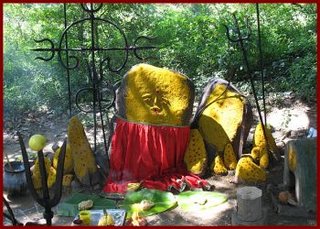www.swanngalleries.com
21 December 2006
Travel Posters
www.swanngalleries.com
Advocates Meeting
Last week during its General Body Meeting, the district organisation of The All India Advocates Association passed a resolution, demanding the Government give a stiped of Rs.3,000/- (USD 70) per month to junior Advocates during the first five years of their career.
Other resolutions passed for the District were related to filling vacancies of vacant Judicial Officer posts and the setting up of a Commercial Crime Investigation Wing Court, Workman Compensation Court and Essential Commodities Act Court.
The Association also demanded the Government appoint members and activate the Tiruvannamalai Consumer Court, weekly sessions for Labour Court, set up a Sub Court in Chengam, construct integrated court complexes at Tiruvannamalai, Arni and Cheyyar and also build new court buildings at Chengam, Polur and Vandavasi.
20 December 2006
Arunachala
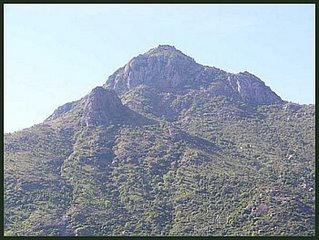
I sought to devour Thee:
Come now and devour me,
Then there will be peace, Arunachala.
You bade me give all for you;
Take now the giver too,
Survive alone, Arunachala!
Let now the deception end.
There was no lover or friend
Apart from Thyself, Arunachala!
Now that at last I know
All this a magic show,
Let it dissolve in Thee, Arunachala!
[By Arthur Osborne]
Parvathamalai
Parvathamalai, a mountain which is part of the Javadhi Hills, is becoming increasingly popular with trekkers and climbers as a pleasant daytrip excursion near Tiruvannamalai. The mountain, which is located in this District, is about 25 kms distant and can be reached by a four-hour trek from Kadaladi or through Thenmadimangalam.
The hike starts from Pachiamman Temple through a thick forest of medicinal herbs and lush greenery. After about 3 kms trekkers reach Gadapparai, from whence begins a ladder of metal steps with iron chains on either side.
At the next incline one has to hold on to iron rods planted on each side of the track until arriving at Mandapam. At this point travel becomes more difficult and trekkers have to walk sideways by clinging to a boulder under an abutting cliff.

From the top of Parvathamalai there is a breathtaking view of the surrounding countryside. A proposal has recently been drafted in consultation with the Collector of Tiruvannamalai for strengthening the infrastructure and facilities throughout that area.
Farming News
Maize cultivation has now started in Tiruvannamalai District through the efforts of the Agriculture Department who wish to improve the production of coarse cereals. In this regard maize promises a high return for farmers compared to other dry land crops.
In order to promote the cultivation of maize, the Agriculture Department is providing interested farmers, with 2kg of hybrid seeds named 'Maharaja-10'. Officials report that these seeds are being treated with fungicides in order to prevent seed-borne diseases and thus ensure a good yield.

Some farmers feel the seed variety to be unsuitable for the production of food stuffs such as corn flakes or puffs and that are preferable varieties which would be more profitable. They have thus requested officials to supply such improved maize seed varieties. Currently maize cultivation has started up on 330 acres in this area
Free Land
Some 453 farmers have now each received two acres of free land in the second phase of the DMK Government's land programme in Tiruvannamalai District. In the first phase of the programme 780 farmers received land.
18 December 2006
Madurai Hills
Madurai Hills
Sri Subramaniaswamy Temple Hill
In an earlier post I wrote that it is customary to celebrate Deepam in all Shiva Shrines at the same time that Deepam is celebrated at Arunachala, however the legend for these Siva Shrines is different to that of Arunachala. You can read more about the origins of Deepam on this Blog.
The Deepam festival follows the moon calendar so each year the date is different however it always falls when the star Krittika is in conjunction with the Moon in the month of Karthika (November-December). To find out the dates of upcoming Poornimas (full moons) and Deepams through to the year 2009, please check the following link:
http://www.arunachalasamudra.org/fullmoon.html
But Deepam is not only celebrated at Siva Shrines in Tamil Nadu. In this respect the Deepam Festival is also celebrated at the famous Subramanian Temple in the Madurai Hills, Tamil Nadu. I am currently trying to get information about the history of the Deepam at this Temple.

But for now I am posting a narrative of the Deepam function celebrated there this year and also a picture of the Temple and its Hill.
"Amidst tight security, thousands of people offered worship as the 'Karthigai Deepam' was lit atop the Tiruparankunram Sri Subramaniaswamy Temple Hill, near the Uchipillayar shrine, at 6 pm today.
Earlier in the morning, hundreds of people participated in the Car festival when the Lord Subramanian and goddess Deivayanai were taken around the Hill. The Deepam festival is part of the Karthigai festival which began on Nov 24th last.
Police had made elaborate security arrangements, and arrested 70 Hindu Munnani volunteers who tried to take out a procession to the Sikander Dargah atop the hill where the ancient Karthigai Deepam mast of the temple was located.
The Hindu Munnani volunteers had been demanding that the Deepam be lit on the original mast. However, as the area was disputed, the Temple Authorities were lighting the Deepam near the Uchipillayar Temple.
Earlier, after special 'Pooja Deepams' were lit in the main temple and all the sub shrines after special poojas. Later, 'Mahadeepam' was lit.
Simultaneously, people living around the Hill illuminated their houses with oil lamps and offered prayers."
Organic Farming
The Confederation of Tiruvannamalai District Farmers Association has urged the Government to promote organic farming by creating avenues for export.
A resolution to this effect was adopted at a meeting of the confederation held at Tiruvannamalai recently. It also urged the Government to take steps to protect land resources from getting eroded by the use of chemical fertilizers and to give training to farmers in producing and using natural alternatives like vermi-compost (worm compost) manure and Panchakavya*.
Another resolution urged the Government to open natural fertilizer sales centres. It was suggested that the Government should give farmers valuable tree saplings like Sandal and Pathimukam (Caesalpinia sapans) to enhance their livelihood and that bankers should be sensitized to give loans to farmers. It was also decided at the meeting to institute an award to honour farmers practising organic farming.
* Panchakavya is a traditional method, used to safeguard plants and soil micro-organisms and to increase plant production.
In Sanskrit, Panchakavya means the blend of five products obtained from cow. It contains ghee, milk, curd, cow dung and urine. Based on detailed discussions with organic growers of Tamil Nadu, experiencing indigenous technical knowledge, the following ingredients were used to prepare approximately 20 litres of Panchakavya stock solution for scientific evaluation. BGS/cow dung (5 kg), cow's urine (3 litres), cow's milk (2 litres), cow's curd (2 litres) and cow's ghee (1 litre).
Andhra Red Rose

A major part of rose cultivation has been limited to Hill Stations and other places having a cool climate, however a rose variety called Andhra red rose is becoming popular with farmers in Tiruvannamalai. There is a demand for more of such flowers, particularly those that are grown organically.
Fresh flowers are mainly used to make garlands and market value products such as rose water, attar and other perfumery materials. Organically grown flowers have a longer shelf life and retain their freshness for more than a day after being plucked, compared to flowers grown chemically.
The flowers come in three different colours; dark red, light pink and white, but farmers mainly prefer the dark red and pink colours for cultivation. The ideal season for growing this variety, mainly propagated through stem cuttings, is April-May.
15 December 2006
Guhai Namasivaya
A few hundred feet away from Virupaksha Cave is a compound which contains a cave that was, several centuries ago, occupied for many years by a yogi called Guhai Namasivaya. The cave and the few buildings that surround it now bear his name and are set in a beautiful, tranquil compound on the Hill slope.
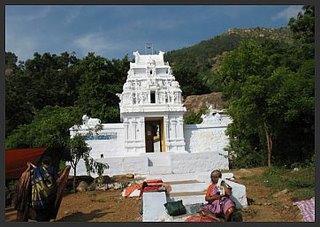
Guhai Namasivaya is known to have been born around the year AD 1548 in Karnataka to a pious Saiva couple. His spiritual nature became evident at an early age: he was virtuous in his conduct, adept at his studies and evinced no attachment to worldly matters.
He practised his system of yoga for many years and as a result of the dream guidance of Lord Mallikarjuna, the presiding deity of Sri Sailam, Guhai Namasivaya came to Arunachala and remained as a Guru, giving teachings to mature disciples who approached him.
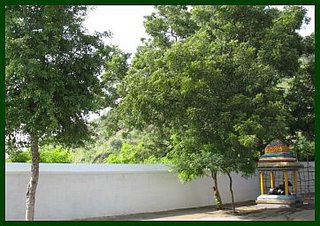
There is a famous story concerning Guhai Namasivaya that seems to show that although he had great devotion to Arunachala, he was still capable of displaying bursts of extreme anger. One day, according to this story, he took pity on a poor man whose only goat had been killed by a snake just before it was about to give birth. Guhai Namasivaya asked the man to leave the goat's body with him and to collect it the next day. When the man returned to pick up the corpse, he found that not only had the goat been restored to life, it had also given birth to two kids.
As news of this miracle spread around the town, some boys from the local weaving community decided to play a joke on him. One boy, pretending to be dead, was carried into the presence of Guhai Namasivaya by his friends. The boys claimed that their friend had died of a snake bite and asked the saint to restore him to life. Guhai Namasivaya, who could see that they were merely making fun of him, cursed them with such vehemence that the boy who was pretending to be dead actually did die.
Then Guhai Namasivaya cursed the whole weaving community, saying that they would never prosper or flourish in Tiruvannamalai again. The curse took effect: all the weavers were forced to leave town or take up other occupations because none of them could make a living by weaving in Tiruvannamalai. In the years that followed, all attempts to re-establish weaving businesses in the town failed.
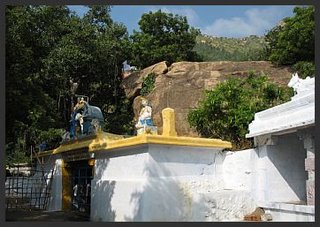
For a fuller biography of this famous saint please check link:
http://www.arunachalasamudra.org/guhainamasivaya.html
13 December 2006
Reforestation Video
Between 1985-1989 the regeneration of Arunachala was something of Apeetha Arunagiri's (an Australian living at Arunachala) personal commitment and passion. However in 1989 the scheme gained official status when ARS (Arunachala Reforestation Society) was formed with her at the helm; a position she would occupy till about 1993.
In 1989 substantial funding started to come after Apeetha contacted RIC (Rainforest Information Centre Inc) for support to regenerate Arunachala to its former forested state. Some of this funding came via the Australian Government aid agency, AusAID and the Threshold Foundation. After initial visits from RIC representatives, an Australian John Button, a permaculture technician and tree planter, remained with the ARS project at Arunachala for eight years to help with the work.
Apart from planting and seeding the barren slopes of Arunachala, the project has focussed on environmental education, establishment of nurseries, skills training, credit schemes in villages, and the refurbishment of traditional gardens in the main temple. Also on temple lands, ARS has regenerated wastelands into productive food, fodder and timber forest.
On the Mountain itself, since 1991, the Arunachala Reforestation Society has been responsible for planting around 5,000-20,000 trees a year. Initially survival rate for the trees was 30% but now that figure stands at the much improved 60-70%.
As a result of a land donation, the ARS has developed a Permaculture Demonstration Farm and Educational Centre. Training and demonstrations in permaculture are held there and surrounding villagers are taught how sustainable land-use patterns can provide food, fuel, fodder, herbs and medicines in the process of the restoration of even severely degraded land.
Rainforest Information Centre
The Rainforest Information Centre Inc., (RIC) is a non-profit, volunteer organisation dedicated to the protection of the Earth's rainforests and the indigenous people who depend on them.
The RIC was born out of a successful struggle to save the sub-tropical rainforests of New South Wales, Australia in the early 1980s. Since then the Organisation has been involved in campaigns and projects to protect rainforests and recognise the legitimate development aspirations of rainforest peoples.
Project Arunachala has been supported by RIC since the late 1980's. The afforestation and environmental regeneration project was initiated in 1988 by Apeetha Arunagiri. She contacted RIC with an outline of the situation and a plea for support for the Annamalai Reforestation Society (ARS) which she established to regenerate the mountain to its former forested condition. In spite of the fact that the district is classified as semi-arid (thus far from the category of rainforest), the decision to work with the project was taken.
In the below video John Seed of the Rainforest Information Centre talks of Arunachala and about the association of the Rainforest Information Centre with the Arunachala Reforestation Society.
If you can not see anything in the below space please activate the cookies on your browser at Tools>Internet Options.
12 December 2006
Walkabout
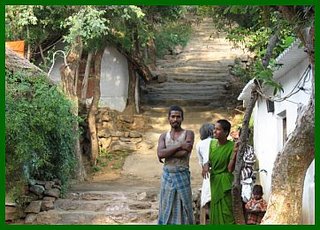
At the beginning of the pathway are huddles of houses, which are in actual fact encroachments that will probably be allowed to remain. As I got further up, the houses thinned out but occasionally spotted a small forest dwelling just off the pathway. This one rather reminded me of the tree dwellers in one of the Star Wars movie!

On the southeast slope across from the Temple is a profusion of caves, small shrines, temples, hutments and tirthams (water tanks).
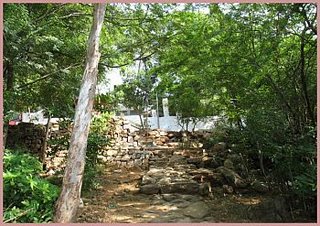
The shrines are beautifully maintained as they receive many visitors and pilgrims who, in the Indian way, give generously whilst on pilgrimage.
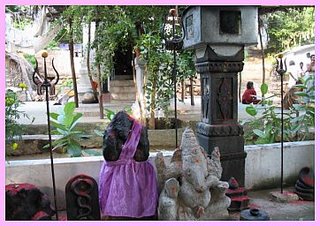
The below photograph is of the inside of the Mango Cave. A famous cave that has been occupied by many saints and sadhus. It was also one of the caves that Sri Ramana Maharshi lived in whilst on the hillside. During his time at Virupaksha Cave, Ramana would (during the hot summer months) generally move to the cooler Mango Cave which also had an ample water supply.
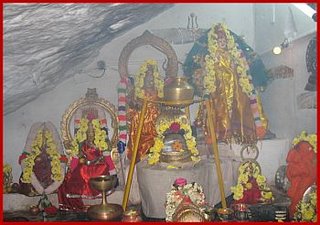
One of the tirthams near the caves.
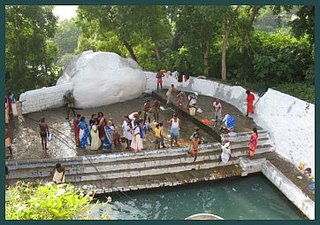
There is always lots of activity at the tirthams. In the below photograph you can see sadhus in the background and in the foreground, pilgrims with shaved heads. The pilgrims probably had their tonsures done at Arunachaleswarar Temple in performance of a vow. After the head is shaved the pilgrim will often cover the head with sandalpaste which is both cooling and also a protection against the sun. It is regarded as very auspicious to take a bath in a water tank around Arunachala. And in this respect some of the specific tanks and the merits accrued from bathing in them are mentioned in the Skanda Purana.
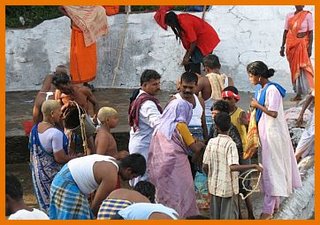
Here is a sadhu colony on the slope.
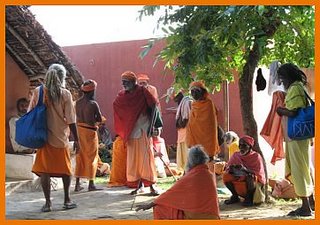
Statue carvers are quite common around Arunachala. Previously they were content in selling their wares off the Chengam Road and near the Temples. But now, due to the huge increase of visiting pilgrims on the pathways surrounding the caves and tirthams on the slope of Arunachala, they have sensibly decided to station themselves where the business end is!
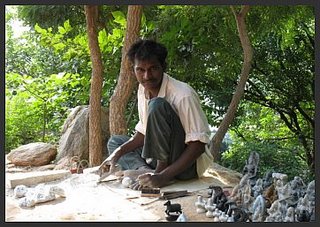
Alot of them are very talented and you can purchase beautifully carved religious icons for a lesser price than in the shops. But remember you are expected to bargain!
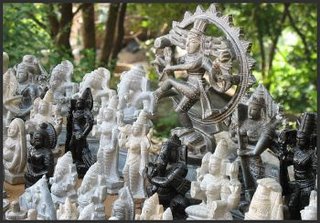
After a pleasing trek around the slopes I take a different pathway back into town.
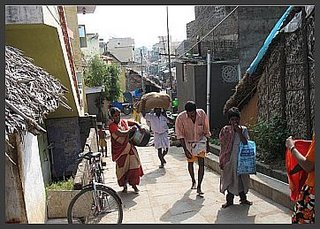
Sacred Grove
Thousands of sacred groves remain and many villages continue to observe traditional practices.

Each sacred grove has a residing deity and folklore associated with it. They are usually dedicated to one of the following:
Village gods and/or ancient spirits;
Snake gods and/or an incarnation of Vishnu,
Shaivite gods (located in dense forests);
Vaishnavite gods (located in dense forests).
The village sacred groves are generally dedicated to Amman, the goddess of fertility and good health.
From time immemorial, certain trees and plants in India have been invested with divine attributes. Hindus have been taught to worship and revere trees and plants in the belief that it would influence their own personal well-being. Evergreen trees were regarded as symbols of eternal life and to cut them down was to invite the wrath of the gods. Groves in forests were looked upon as habitations of the Gods.
The banyan tree occupies the pride of place amongst the sacred trees of India. It has aerial roots that grow down into the soil forming additional trunks. It is, therefore, called bahupada, the one with several feet. It symbolizes a long life and also represents the divine creator, Brahma. It is invariably planted in front of temples. The numerous stems of the banyan tree are even regarded as the home of gods and spirits. It was under a banyan tree that the Hindu sages sat in a trance seeking enlightenment and it was here that they held discourses and conducted holy rituals.
The trees generally associated with sacred groves are the Banyan, Peepul and Neem trees.
In Tamil Nadu there has always been a strong tradition of nature worship and animism. Adjacent to the land of Rangammal School for the Hearing Impaired, there is a small, perfect grove with a beautiful banyan tree and a stone icon representation of Kali Ma. This sacred site has been revered by local villagers for an indeterminate time.

I was fortunately able to be present during a puja at the Sacred Grove and was able to hear about a fascinating experience one of the local teachers had at the shrine.
She told me that years back, after hearing about the Sacred Grove, she decided to visit it and pray to the representation there of the Divine Mother in the form of Kali Ma. When she arrived at the Grove there was a live cock hanging upside down from the metal frame on the left hand side of the stone icon. (The frame actually says OM in the Tamil language).
The frightened confused cock severely hurt himself on the protruding metal prongs and it got messy and nasty at the shrine. Frightened and distressed the teacher ran back to the school leaving everything as she found it. She was to learn that a black magician had tied the cock upside down at the Kali Ma icon as part of a magic ritual that he was performing for a client. For the teacher things were getting worse and worse. First the cock and now a black magician! So, believing that the place was cursed, she vowed never to go back to Kali Ma at the Sacred Grove.
Unexpectedly a mysterious, unknown stranger went to the teacher and told her not to be frightened and that he had 'spiritually cleansed the Sacred Grove and Kali Ma wanted her to come each month and perform puja there.'
Since that time now many years ago, the teacher regularly goes to the Sacred Grove. Also once a month, as commanded by the Divine, she performs worship at the Kali Ma shrine. She told me that she has found answers to all her prayers at the Sacred Grove and she knew it to be an extraordinary and powerful site where wishes come true.
Fire Starter
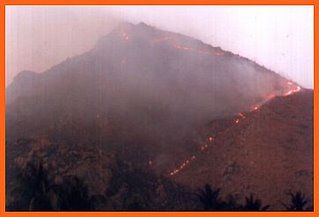
The greatest danger to all reforestation programmes being undertaken at Arunachala is the possibility of fire. The fires are mostly man-made. In previous years wood cutters would raze dry existing grass on the Hill to promote new growth. Sometimes the fire was caused by people out of the superstitious believe that setting the Hill alight would somehow benefit their health or prospects.
What previously was shrugged off by the Municipality as high jinks is now being taken very seriously. In this respect a 52-year-old man of Thenimalai, a suburb of Tiruvannamalai, was arrested by forest department officials for allegedly causing a fire in the Tiruvannamalai hills on Saturday, December 9th.
According to sources, unidentified miscreants set grasses and woods in the hills on fire, causing damage to the area and particularly to trees developed by the afforestation programme carried out by the Forest Department and various Non Governmental Organisations (NGOs).
Fire-fighting squads and a team of volunteers helped extinguish the fire. The miscreant Palani, who was detained for allegedly causing the fire, is said to have confessed to his offence, saying that he committed the arson, driven by the superstition that setting the hills on fire would cure stomach ache!
State Transport

P Lokanathan has been appointed as special officer for the upcoming new region of State Transport Corporation (STC).
During the last assembly session the Government announced the formation of a new State Transport Corporation region based at Tiruvannamalai.
Though Tiruvannamalai District was formed nearly two decades ago, there is no separate State Transport Corporation division for this District. As buses from the Vellore, Villupuram and Kancheepuram divisions are operating their buses in certain parts of this District, the Government decided to form a separate region based at Tiruvannamalai to bring the entire District under one administration.
Wasteland
It was recently announced that the Government would help farmers improve their waste lands. In this respect if a small farmer wishes to get wasteland improved by the Government, they need first apply to the respective Tahsildar (local land official) with details of the land.
The Tahsildar would in turn, send a report to the Director of Agriculture with full details about the land and then Department officials would decide on the nature of improvement and take up the work after consulting with the farmer.
Levelling of the land, removing bushes, setting up bunds, conducting soil tests, digging bore wells and providing pump sets would be some of the general improvements. Only lands which have been uncultivated for more than five years would be considered for improvement.
9 December 2006
Deepam Security
Now that the day of the lighting of the Deepam flame is over and the crowds have receded we can look back and be grateful at how orderly the huge function proceeded.
Everything changes with time. Procedures at airports are becoming increasingly long drawn out, CCTVs are now a way of life in most major Western cities and ubiquitous passes and permissions become ever increasingly divided into more exclusive and security-rated categories.
The last few years have not been happy ones in some Temples here in India and it is only appropriate that proper security was observed at Tiruvannamalai during this important and busy Festival. And yet, it seems so strange compared to just a few years ago, when everything was simple, relaxed, spontaneous and stress free.
This year nearly 6,000 police personnel (including reserve police, Tamil Nadu special police force and regular police from various State zones) were deployed at this year's Karthigai Deepam to ensure the safety of a million pilgrims during the climatic lighting of the Maha Deepam at dusk on December 3rd.

For the first time this year all Temple Staff, including priests had to wear identity cards. All entry points to the Temple were monitored by Close Circuit Television (CCTV) and by crime experts (from all 30 Tamil Nadu State Districts) and designated entrances were allocated to visitors to Temple.
During the Maha Deepam Festival 16 criminals were arrested for their involvement in various criminal activities including theft. And 41 people, who became lost in the huge crowd, were reunited with their families with the help of police. Traffic was well managed soon after the Deepam festival concluded and no traffic congestion was reported.
One could say COMPLETE SUCCESS.
Ramana Video
I am posting this very nice compilation of Archive Films and Photos of Ramana Maharshi produced by Arjuna Deva. If you can not see anything, please enable 'cookies' on your browser at Tools>Internet Options.
Cultural Programme
In a previous post I mentioned the extraordinary work being done by the Rangammal Memorial Rehabilitation Society set up by Sylvia Wright. As part of that Society, in 1992 The Rangammal Memorial Higher Secondary School for the Hearing Impaired was established here in Tiruvannamalai. The school has a high reputation for academic and cultural excellence. It is totally free of cost and currently has 200 residential and 36 non-residential pupils. There is no charge for food, board or study books.

I recently returned on a second visit to the school and spent some happy time with the children and staff. During my visit I was able to watch the children practise a dance routine they were preparing for a cultural function associated with 'The World Disabled Day' to be held December 3rd at Chennai.
In the below photograph the children are preparing different sequences of their programme. Both the youngest and the oldest at the school are being represented. The children are wearing their school clothes, but I was assured by Madam Krishnabai (the Headmistress of the school) that very colourful and elaborate costumes were being prepared for the kids to wear during their programme at Chennai.
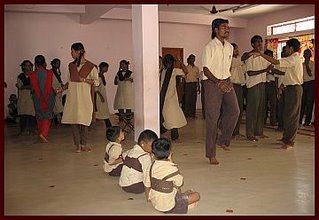
I sat and watched the whole routine the kids were preparing. Of course I (like the audience in Chennai), watched the children perform to music. Their movements and gestures were so perfectly timed to music that it was difficult to believe that most of them are completely deaf. It was a joy to watch their happy, jubilant faces while they were dancing. One teacher sat in front of the children with a large drum and the kids took their cues from the timing of the beating of the drum and also from various hand signals made by the teacher. It was a truly breath-taking performance.

A total of 65 children representing Rangammal Memorial Higher Secondary School for the Hearing Impaired travelled to Chennai to participate in the programme. Needless to say the kids won and after a brief stay at Chennai returned triumphantly to Tiruvannamalai with their trophy shield and wonderful memories.
Transformer Failure

The prolonged failure of an electric transformer at Vedanthavadi village, Tiruvannamalai District, has left around 200 acres of paddy and peanut crops to wilt as irrigation motors have came to a halt for the last two months.
The transformer, which feeds power to irrigation pumps in the village, developed a snag two months ago and since then power supply remained disrupted resulting in crops withering without water, said villagers.
When village members contacted the Electricity Board, they were told that it would take another 15 days for the transformer to get repaired. Since there is no power supply in the line to the pumps, burglars have been stealing the electric cables.
This sad story is very much a throw-back to yesteryear. My own experience is that the infrastructure in this area has improved immensely. However, one does get isolated rural pockets that perhaps have (thus far) not benefited as much as their urban brethern. Overall things are getting better here and perhaps worse in more developed countries. We are certainly experiencing changing times as it seems like even Western countries are no longer able to rely on the effective working of their own infrastructure.
8 December 2006
Wonderful World
[To view this page please enable 'cookies' at Tools>Internet Options on your browser bar]
